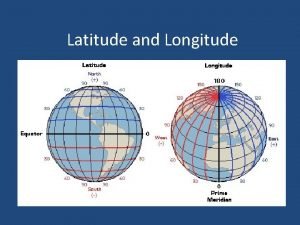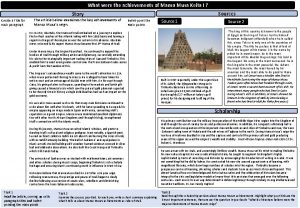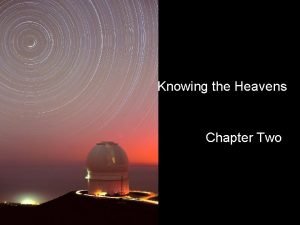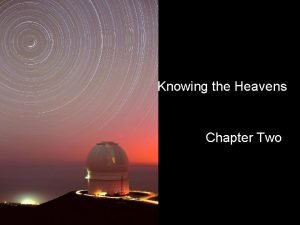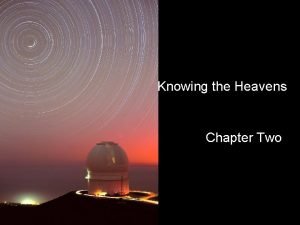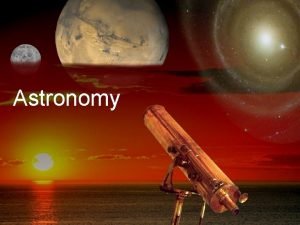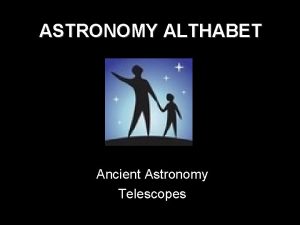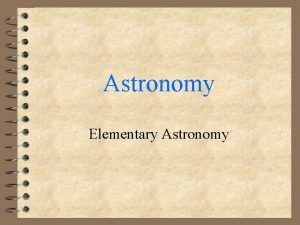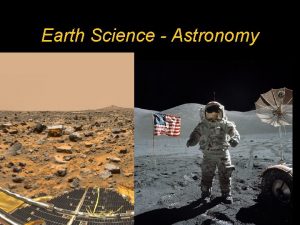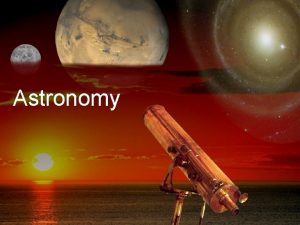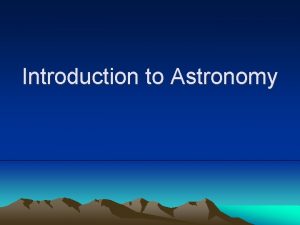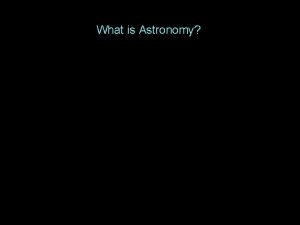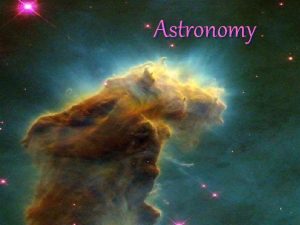NakedEye Astronomy The most important graph 2 1r





















![Celestial Coordinates Earth: latitude, longitude Sky: • declination (dec) [from equator, +/-90°] • right Celestial Coordinates Earth: latitude, longitude Sky: • declination (dec) [from equator, +/-90°] • right](https://slidetodoc.com/presentation_image_h2/9755f3babcc12550fbf3f947038620df/image-22.jpg)


- Slides: 24

Naked-Eye Astronomy

The most important graph: 2 1/r • Force of gravity (and EM) falls off like that • Brightness of stars goes down like that • Simple reason: – things spread out over a sphere – dilutes over the surface of the sphere – surface scales like r 2

Example: Two 100 W light bulbs • One APPEARS nine time brighter than the other. How far away is it? • We can’t compute how far away it is in absolute terms, but it must be √ 9=3 times farther than the other one. • Which one is brighter?

Appearances • Don’t be fooled by appearances! – The sun and the moon appear to be the same size in the sky (0. 5 degrees) – Alpha Centauri appears to be much dimmer than the Sun – Alpha Centauri and Vega appear to be equally bright

Think! • The moon and the sun COULD be at different distances • Alpha Centauri and Vega COULD be different types of stars • Find out Measure! • That’s where science starts

Homework • Typing in formulae in Web. Assign: • Area of circle is pi*r^2 • Webpage: – http: //faculty. otterbein. edu/utrittmann/is 2403 -02 • Web. Assign: www. webassign. net

Peer Instruction: How it works • Peer instruction is learning by instructing your fellow students and being instructed by them • The process involves 6 steps: – Mini-lecture by course instructor – Conceptual multiple-choice question is put up – Flash-cards are used to “poll the audience” – A few minutes of discussion between students – “Final answer” via flash-cards – The instructor explains the correct answer

Concept Questions • Concept questions maybe easy to answer, but are not simple • You need background knowledge to answer them • They teach you how to use facts and knowledge to find the answer to a problem • They test if you got the concept rather than just knowing facts

Why it works • Carefully chosen questions • It is easier to be convinced and to convince if the reasoning is sound and hence the answer correct How answers are revised in a typical question Right to right Wrong to right Right to wrong No 2 nd answer wrong to wrong

What is Astronomy? • The science dealing with all the celestial bodies in the Universe – Cosmology is the branch of astronomy that deals with the cosmos, or Universe as a whole • The medieval list of the Liberal Arts: grammar, rhetoric, logic (trivium); arithmetic, music, geometry and astronomy (quadrivium) • Is an “exact science” for ~5000 yrs – Most rapid advancements in astronomy have occurred during the Renaissance and the 20 th century – Success has been a result of development and exploitation of the scientific method

Why study Astronomy? • Practical reasons: seasons, tides, navigation, space technology, satellite communication • Idealistic reasons: cosmological questions (“Where do we come from? ”), aesthetics, curiosity “Two things fill the mind with ever new and increasing admiration and reverence, the more frequently and enduringly the reasoning mind is occupied with them: the star spangled sky over me and the moral law in me. ” (I. Kant)

Astronomy and Culture • Astronomy had and has an enormous influence on human culture and the way we organize our lives • For example: – The year is the rotation period of the Earth around the Sun – The year is subdivided into months, the period of the Moon around the Earth – The weeks seven days are named after the seven bodies in the solar system known in antiquity: Sunday, Monday, Saturday (obv. ), Tuesday=Mardi, Wednesday = Mercredi, Thursday=Jeudi, Friday=Vendredi

What’s in the Universe? Stars nebulae molecular clouds star clusters THE UNIVERSE clusters and superclusters galaxies like the Milky Way quasars voids Solar System black holes pulsars Sun planets moons comets meteors asteroids dust terrestrial jovian

Basic Observations in Astronomy • Positions of objects (sun, moon, planets, stars …) • Motion of objects – with respect to you, the observer - with respect to other objects in the sky • Changes (day/night, seasons, etc. ) • Appearance of objects (phases of the moon, etc. ) • Special events (eclipses, transitions, etc. ) All “in the sky”, i. e. on the Celestial Sphere

Position: Angles vs. Distances • Locations in the sky are easy to measure: 2 angles • Distances from observer are hard (one length) Together they give the location of an object in three-dimensional space

Angles and Angular Size • Angles measured in degrees – – – • full circle = 360 ; right angle = 90 1 = 60' (minutes of arc or arc minutes) 1' = 60" (seconds of arc or arc seconds) Typical angular sizes: – Moon 0. 5 , Sun 0. 5 , Jupiter 20”, Betelgeuse (α Ori) 0. 05”

The Trouble with Angles • Angular size of an object cannot tell us its actual size – depends on how far away it is • Sun and Moon have very nearly the same angular size (30' = ½ ) when viewed from Earth

Without Distances … • We do not know the size of an object • This makes it hard to figure out the “inner workings” of an object • We can’t picture the structure of the solar system, galaxy, cosmos

The most important measurement in Astronomy: Distance! • The distances are astronomical! • The distance scales are very different – Solar system: light minutes – Stars: light years – Galaxies: 100, 000 ly – Universe: billions of ly • Need different “yardsticks”

Yardsticks and the Expanding Universe • Realizing (measuring) the distances to objects means realizing how big the universe is: – We realized that the solar system is not the universe – We realized that our galaxy is not the universe – We realized that the universe is not static

What’s up in the night sky? The Celestial Sphere • An imaginary sphere surrounding the earth, on which we picture the stars attached • Axis through earth’s north and south pole goes through celestial north and south pole • Earth’s equator Celestial equator
![Celestial Coordinates Earth latitude longitude Sky declination dec from equator 90 right Celestial Coordinates Earth: latitude, longitude Sky: • declination (dec) [from equator, +/-90°] • right](https://slidetodoc.com/presentation_image_h2/9755f3babcc12550fbf3f947038620df/image-22.jpg)
Celestial Coordinates Earth: latitude, longitude Sky: • declination (dec) [from equator, +/-90°] • right ascension (RA) [from vernal equinox, 0 -24 h; 6 h=90°] Examples: • Westerville, OH 40. 1°N, 88°W • Betelgeuse (α Orionis) dec = 7° 24’ RA = 5 h 52 m

What’s up for you? Observer Coordinates • Horizon – the plane you stand on • Zenith – the point right above you • Meridian – the line from North to Zenith to south

…depends where you are! • Your local sky – your view depends on your location on earth
 Learning astronomy by doing astronomy
Learning astronomy by doing astronomy Learning astronomy by doing astronomy activity 1 answers
Learning astronomy by doing astronomy activity 1 answers Learning astronomy by doing astronomy activity 1 answers
Learning astronomy by doing astronomy activity 1 answers Newspaper article format
Newspaper article format Inverted pyramid in news writing
Inverted pyramid in news writing Least important to most important
Least important to most important The most important graph in the world
The most important graph in the world Doctrine and covenants 130
Doctrine and covenants 130 Salamanca statement summary
Salamanca statement summary What is meant by resocialization
What is meant by resocialization Example of resocialization
Example of resocialization Most important part of the body
Most important part of the body An imaginary horizontal line of the earth
An imaginary horizontal line of the earth 2 most important commandments
2 most important commandments эссе the most important thing in life is work
эссе the most important thing in life is work Describe shampooing for wheelchair bound clients
Describe shampooing for wheelchair bound clients What were mansa musa's most important achievements
What were mansa musa's most important achievements The most important night of melanie's life
The most important night of melanie's life Water is one of the most important resource
Water is one of the most important resource The most important component
The most important component Most important organelle
Most important organelle Site:slidetodoc.com
Site:slidetodoc.com Speaking mathematically
Speaking mathematically Element of a plot
Element of a plot Nomenclature of ether
Nomenclature of ether












